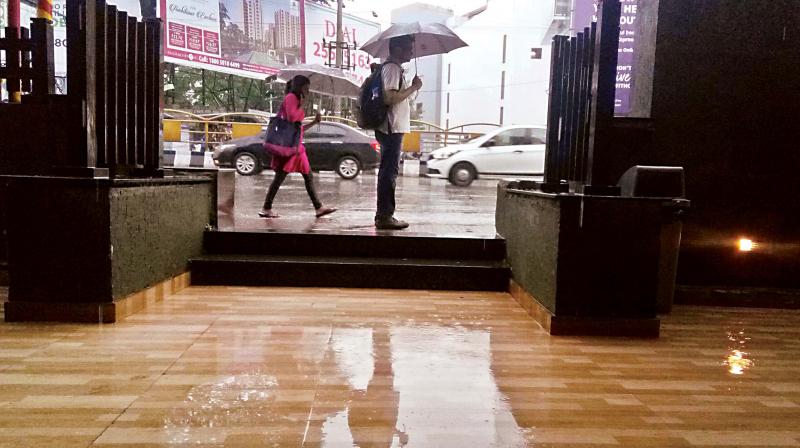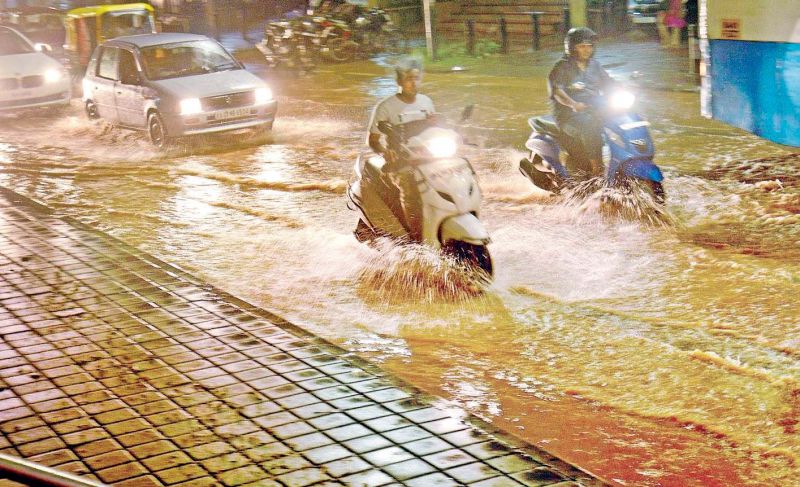White topping over the top, Bengaluru flooded
BBMP launching a massive project for white topping of several roads in what was considered an ambitious move to get rid of potholes.

Just before the Assembly polls, the city saw a splash of white with the BBMP launching a massive project for white topping of several roads in what was considered an ambitious move to get rid of potholes. But the Palike’s shoddily and unscientifically executed project has left shop owners, pedestrians and motorists fuming. Reason— the concretised roads are now at a level 20 cms higher than footpaths and have blocked shoulder drains leading to water-logging even on stretches which were not prone to flooding earlier. Experts wonder if the project was really worth it and more so when obsolete technology was adopted- ultra-thin concrete measuring 10 cms could have been laid within 3 days. Aknisree Karthik reports
BBMP officials are trying to defend white-topping of roads, saying they are the solution to the pothole-ridden city, but citizens are worried as road levels have risen significantly, putting business establishments on roadsides in danger of flooding.
On Adugodi Main Road, Koramangala 80 Feet Road, 20th Main Road, Mysuru Road and West of Chord Road, the height of the roads have risen, pushing the footpaths and nearby shops and other establishments below them. When it rains heavily, water enters their establishments causing inconvenience.
A representative of a bookstore on Koramangala 80 Feet Road told Deccan Chronicle, “We have been running our business here for many years now. For our customers, we have reserved the entire basement for parking. We were enthusiastic when the workers started removing the old asphalt to lay the concrete road. But only after it was laid, we have started facing problems. When it rains heavily, water enters our basement, instead of the drain. That is because the height of the road is higher than the drains. Earlier, the road was below the footpath and water used to run off into the drains.”
Representatives of a temple and an NGO on Koramangala 20th Main Road complained that after the road was concretised, they had to spend money to build barriers to prevent rainwater from entering their premises and polluting their water tanks. Shopkeepers on Mysuru Road too face the problem of flooding during heavy rains.
Civil evangelist V. Ravichandar said, “This happens if drains are not built properly while carrying out the white-topping project. The location of drains and drain access points from the road are important for water to flow out.”
He said that one does not get a sense of standardisation in the white topping project. “There are varying heights of footpaths. Further, the contractors have not taken care while improving footpaths (wider and cleaner) and ensuring vehicular lanes of uniform width. Ideally, the road needs to be surface milled (height of the road reduced) and planned in such a manner that the final height difference between the laid road and the footpath is 6 inches (max). Also, the drain openings should not be obstructed and rainwater should be allowed to flow into underground drains.”
He said, “It is necessary to use the white topping project to make proper pedestrian footpaths (wider and well laid) and uniform vehicle lanes. Where there is surplus space, they need to plan bus-stops and parking and hawker zones.”
TenderSURE Phase 3 in initial stages
While 12 roads are being developed under two phases of TenderSURE project, the BBMP, which was waiting for the Assembly elections to get over to resume the works, has commenced the preliminary works.
A BBMP engineer, who did not wish to be named, said, “In the budget, it was proposed to develop 43 major roads of about 80 km with white topping. They will also be upgraded with pedestrian-friendly facilities. The entire project will cost Rs 690 crore. The project recently got the cabinet nod and we will follow the procedures and start the works by year-end.”
He said, “25 interconnected roads in the Central Business District (CBD) of 25 km length will be comprehensively upgraded under the TenderSURE model phase 3 at a cost of Rs 250 crore. Majority of them are in and around K R Market and Majestic areas.”
Among the roads in the CBD that are to be remodelled under phase 3 are Subedar Chatram Road, Gubbe Totadappa Road, W.H. Hanumanrappa Road, K.R. Market, K.G. Road, Avenue Road, Kalasipalya, Malleswaram, Palace Road, Museum Cross Road and Brigade Road.
On the stretches where the works are put on hold, the engineer said, “Works were halted majorly because of model code of conduct. Also the traffic police informed us that they will give their clearance to resume works only on stretches where an alternative road can be provided for the smooth flow of traffic."
He said the works will be taken up soon on pending stretches.
Guest Column: ‘More the money spent, more the kickbacks’
M.N. Srihari Road and Transport Engineering Expert
For anything to be in proper order, it should basically be transparent and cost-effective. To lay a kilometre of white-topped road, the BBMP is spending nearly Rs 8 crore. Is it worth the money spent?
The very design is riddled with flaws. White-topped roads are anywhere between 15 and 20 cm high. This has significantly raised the height of the roads and reduced the height of the footpaths. On stretches like West of Chord Road, Koramangala and Adugodi, several shops and establishment have gone below the level of the road. During heavy rains, these places will be flooded.
Any big project will always be in the good books of politicians and officials. So is the height of concrete roads. This is to ensure that they can spend more money. More the money spent, more the kickbacks. Before laying the concrete, surface milling has to be done and the existing bitumen has to be completely removed. If that had been done properly, the road height would not have increased so dramatically. Further, the road should have side slopes so that rainwater flows into the drain. Even this is not being followed properly.
The white-topping project was started with much fanfare just before assembly polls and was stopped when the model code of conduct kicked in. I really wonder why officials are still sticking to such thick concrete when the job can be done with ultra-thins concretes. They are now laying 15-20 cm of concrete, when it can be done with just 10 cm. They don’t need months to cure. They can be laid and thrown open to the public in just three days. Technology is advancing, but the civic body is lagging behind sticking to outdated ones.
 Image for representational purpose only.
Image for representational purpose only.
Problems and Solutions
What is the problem?
As white topping has been done unscientifically, the height of the road has gone up considerably. Road levels are now 15-20 cm higher, which has increased the threat of flooding of roadside establishments during heavy rains.
How much does it cost to lay a kilometre of concrete road?
White topping costs between Rs 8-9 crore per kilometre.
Which are the areas facing problem?
The height of Adugodi Main Road, Koramangala 80 Feet Road, 20th Main Road, Mysuru Road and West of Chord Road has gone up, pushing the footpaths and nearby shops and other establishments below them.
Why is the problem?
This is because the concrete has been laid in a hurry without proper surface milling (to reduce the height of the road).
What do experts suggest?
Civil evangelist V. Ravichandar said that the roads should be planned in such a way that the final height difference between the laid road and the footpath is 6 inches (max). Traffic expert M.N. Srihari said that the height of the road has been increased as per the whims and fancies of officials as they can make more money out of this. Options of ultra-thin white topping should be explored.

